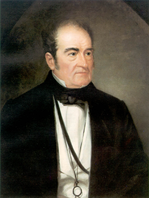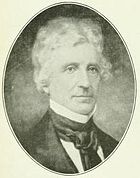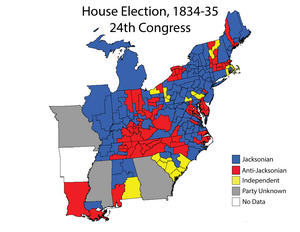United States House of Representatives elections, 1834
|
|
|||||||||||||||||||||||||||||||||||||||||||||||||||||||||||||||
|
|||||||||||||||||||||||||||||||||||||||||||||||||||||||||||||||
|
|||||||||||||||||||||||||||||||||||||||||||||||||||||||||||||||
|
|
|||||||||||||||||||||||||||||||||||||||||||||||||||||||||||||||
|
|||||||||||||||||||||||||||||||||||||||||||||||||||||||||||||||
Elections to the United States House of Representatives for the 24th Congress were held in 1834 and 1835.
In this election, the dominant Jacksonian Party, or Democrats, retained their majority, neither gaining nor losing seats from 1832 to 1833. However, their primary opponents, the Anti-Jacksonians, who by this time were transitioning into becoming the Whig Party, gained at the expense of the Jacksonians as well as the two single-issue parties, the Anti-Masonic Party (an anti-Masonry movement) and the Nullifier Party (a John C. Calhoun-led states' rights party that supported South Carolina during the Nullification Crisis in 1832 and 1833).
The Whig Party, which evolved from the National Republican Party, attempted to change its image and reach out to new groups, including conservative Jacksonians, anti-Masons, and former Federalists. The Whigs would soon be able to gain a number of seats due to the unpopularity in some regions of Andrew Jackson's brash style. A number of former Jacksonians left the party and joined the newly formed Whigs in opposition to the perceived autocratic style of the president.
...
Wikipedia




